
Earlier this week we discussed some Far East medical practices that may be helpful for COPD patients or those with other respiratory illnesses. Many exercises such as Tai Chi, Qigong, or Yoga contain a mindful breathing component that can be helpful for oxygen patients as well. In addition to lung capacity, many with lung diseases also battle, depression, anxiety, and sleep problems. These exercises have have also been proven beneficial for those conditions.
Tai Chi
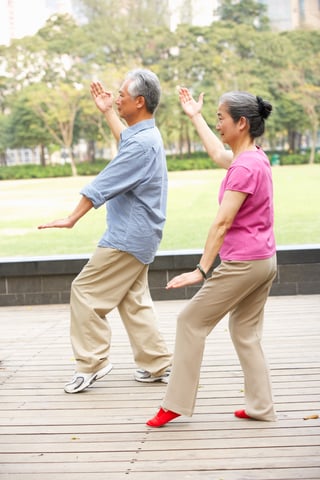 Staying active when you are living with COPD or any chronic disease can be challenging but it is extremely important. The gentle, sweeping movements of Tai Chi are low impact and good for joints and muscles, and the breathing skill component to this exercise is extremely valuable to those with lung health conditions.
Staying active when you are living with COPD or any chronic disease can be challenging but it is extremely important. The gentle, sweeping movements of Tai Chi are low impact and good for joints and muscles, and the breathing skill component to this exercise is extremely valuable to those with lung health conditions.
Tai Chi Chuan was developed as a martial art over 1000 years ago. It is still practiced by millions of people ever day all around the world. This exercise encompasses breathing, visualizations, and carefully choreographed movements to get energy flow throughout the body in alignment.
There are many forms of Tai Chi taught today. One of the styles ranked among the most suited for COPD sufferers is called the Sun style. It came to prominence about 100 years ago and was developed by Sun Lu-tang. The tempo of this method is slow so that beginners can easily learn the postures correctly to get maximum benefit. In many styles of Tai Chi, practitioners bend their knees low to the ground but the stance in Sun style is much higher which is easier to do without joint strain. Patients who have practiced Tai Chi have reported greater endurance, fewer exacerbation events, and improved mood. Not only is Tai Chi good for those with muscle and joint problems but studies have shown that it is safe for those with chronic diseases such as COPD, artery disease, or those recovering from heart surgery or heart attack.
According to one of the experiments documented in Bio Med Central, Tai Chi’s benefit is threefold; physical exercise, mindfulness and relaxation, and respiratory training.

Physical Exercise
The benefits of exercise for COPD patients have been well documented in both improving quality of life, and slowing the progression of the disease. Strengthening the muscles of the upper extremities improves muscles around the rib cage that assist with breathing. Tai Chi also increases core strength which helps with posture. Good posture makes it easier for the respiratory muscles to do their job. Many people look at those slow movements and think, “That’s not really exercise.” It looks very different from running on a treadmill or lifting weights but with deliberate, measured movements, I think you’ll be surprised how quickly you work up a sweat.
Respiratory Training
COPD patients struggle with shortness of breath and labored breathing caused by respiratory muscle weakness and lung damage. The deep, mindful breathing techniques that are practiced in Tai Chi encourage fuller, more efficient breathing that improve the mechanics of the chest wall.
Mindfulness and Relaxation
The deliberate movements of Tai Chi encourage awareness of sensation, breath, and emotion. This physical and emotional awareness may help patients when they begin to feel a coughing or shortness of breath episode coming on. Instead of tensing up, causing breath to get more rapid and shallow and exacerbating the problem, patients can turn to calming and more deliberate breathing. Calming emotions and focusing on symptom management can be beneficial for quality of life and stave off worsening dyspnea.
Additional Benefits of Tai Chi
- Soothes depression and anxiety
- Raises energy levels
- Discourages unhealthy emotional crutches such as over eating
- Improved strength, balance, and flexibility will prevent future injuries
- Provides opportunities for greater social interaction and support
- Valuable stress management tool
- Enhances overall health
Where Can I Learn Tai Chi?
- There are several schools all across the nation
- Some recreation centers offer classes
- Many Taoist temples offer classes even if you have no interest in becoming a member of the temple
- There are greater benefits to taking a class with others but if you have a hard time getting out or live in outlying areas, there are literally over 300,000 Tai Chi videos on YouTube.
Qigong
Qigong and Tai Chi look very similar at first glance. They are both slow, meditative  exercises that are aimed at increasing strength and flexibility. The main difference is that Tai Chi was initially developed as a martial art while Qigong is strictly focused on circulating and harmonizing Qi, or healing one’s life force. As a result, Qigong has more fluidity and no defensive type postures or maneuvers.
exercises that are aimed at increasing strength and flexibility. The main difference is that Tai Chi was initially developed as a martial art while Qigong is strictly focused on circulating and harmonizing Qi, or healing one’s life force. As a result, Qigong has more fluidity and no defensive type postures or maneuvers.
This method of exercise may be even more beneficial to those with mobility challenges or more advanced respiratory disease. As with Tai Chi there are millions of Qigong classes being taught worldwide. Google, Qigong in your area and you will likely find several nearby. There are many videos online as well. As the flow of Qi increases in your body you are also likely to have better range motion as well as elevated energy levels. Strengthening of the muscles that support the respiratory system as with Tai Chi, is one of the greatest benefits for those with lung ailments.
Yoga
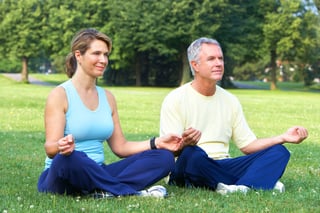
The popularity of the 5,000 year old practice of yoga has exploded in this country over the past couple of decades. In major urban areas it’s not uncommon to see a yoga studio every few blocks. This practice was born in northern India where it was developed by the Indus-Sarasvati civilization. In the late 1800s, yoga masters began to travel to the new cities of the west, bringing their practices with them. The interest in yogic practices grew in the 1960’s as celebrities like The Beatles, Rolling Stones, and many Hollywood stars traveled to India to stay at ashrams and study under yogis. It’s popularity has steadily increased since then.
The practice of yoga is said to be made up of eight limbs.
- Asanas are physical poses or postures. These poses are specifically designed to increase strength and endurance.
- Pranayama is the practice of breath control and specific breathing exercises.
- Samadhi is a union with the divine or inner self.
- Niyama is the awareness of one’s physical sensations, and emotions.
- Dharana is cultivating ongoing self-awareness.
- Dhyana is the devotional aspect to yoga.
- Pratyama is the practice of developing control over the senses.
- Yama is the Sanskrit word for moral discipline.
Asanas and pranayama are the two main aspects that are beneficial for respiratory patients.
Asanas
The physical poses strengthen muscles and add flexibility. This decreases the chance of injury and improves core strength. As with Tai Chi, improved core strength leads to better posture which makes breathing easier. They also reduce inflammation making the movement of blood and oxygen smoother and easier. Better exchange of oxygen and blood gasses will also boost energy.
Pranayama
The art of concentrated breathing helps with maximizing the efficiency of the respiratory system. It also strengthens respiratory muscles overall. Controlled breathing also releases physical tension and relaxes the mind. The shortness of breath that those with COPD often experience is from not being able to exhale fully resulting in not as much fresh air being inhaled. Using deep breathing techniques helps the patient to fill as well as empty the lungs more fully. These techniques can also help to quell panic if breathlessness occurs.
Some Yoga Practices that are Good for the Lungs
Deep Breathing
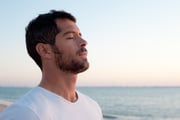
Breathe in as deeply as you can. Hold for a couple of seconds and exhale as fully as you can by contracting the muscles in your stomach and diaphragm. Concentrate on contracting your lower abdomen. Learning to raise your diaphragm in this way will train you to breathe more deeply.
Forward Bends
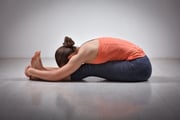 Sit on the floor with your legs straight in front of you. Bend as far forward as you can and feel your hamstrings stretch, hold for 10 seconds. As an alternative you can kneel and bend forward, relaxing your neck and dropping your head. If you cannot get on the floor you can also sit in a chair and lean forward as far as you can, with your hands touching the floor if you are able. Again, drop your head and relax your neck.
Sit on the floor with your legs straight in front of you. Bend as far forward as you can and feel your hamstrings stretch, hold for 10 seconds. As an alternative you can kneel and bend forward, relaxing your neck and dropping your head. If you cannot get on the floor you can also sit in a chair and lean forward as far as you can, with your hands touching the floor if you are able. Again, drop your head and relax your neck.
Side Bends
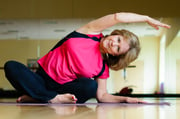 Stand with your feet shoulder length apart or sit with legs crossed. Bend slowly from the waist with your hand over your head and reaching for the side you’re bending toward. Be sure to bend your neck as well. This exercise will strengthen the diaphragm.
Stand with your feet shoulder length apart or sit with legs crossed. Bend slowly from the waist with your hand over your head and reaching for the side you’re bending toward. Be sure to bend your neck as well. This exercise will strengthen the diaphragm.
Additional Benefits of Yoga
- Stress Reduction
- Calms Anxiety
- Overall Fitness Improvement
- Lowers Blood Pressure
- The American Lung Association has Listed Yoga as a Practice that can Help You Quit Smoking and Stay Quit
- Adaptable for Those with Mobility Challenges
- Can Sometimes Replace Traditional Pulmonary Rehab
Cautions for New Exercise Programs
- Always speak to your doctor or respiratory therapist first.
- Try to find a teacher or studio that has experience with working with those with respiratory conditions.
- Keep inhalers nearby just in case.
- If you feel too short of breath, stop and rest.
- Communicate with your teacher and let them know that you have respiratory issues and tell them you can’t do any movements that will press on your diaphragm.
What if I don't want to Participate in the Spiritual Aspects of the Exercise?
Most studios or classes are open to speaking about the spiritual aspects of these exercises but these are not missionary opportunities by any means. Most practitioners know that in the west, many people are coming for the fitness, and wellness opportunities offered and that is all. If it is something you are concerned about, ask before going to set your mind at ease.
We hope that one of these practices start you on a new road to wellness! Good Luck!



